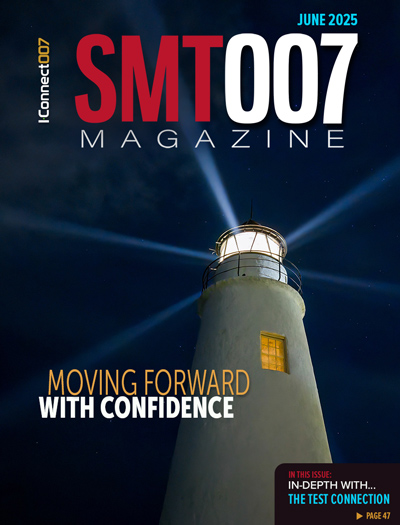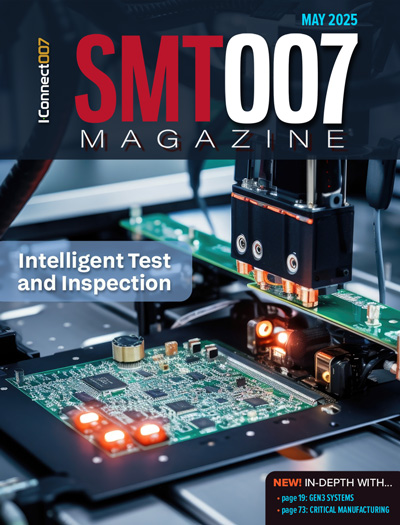-

- News
- Books
Featured Books
- smt007 Magazine
Latest Issues
Current Issue
What's Your Sweet Spot?
Are you in a niche that’s growing or shrinking? Is it time to reassess and refocus? We spotlight companies thriving by redefining or reinforcing their niche. What are their insights?

Moving Forward With Confidence
In this issue, we focus on sales and quoting, workforce training, new IPC leadership in the U.S. and Canada, the effects of tariffs, CFX standards, and much more—all designed to provide perspective as you move through the cloud bank of today's shifting economic market.

Intelligent Test and Inspection
Are you ready to explore the cutting-edge advancements shaping the electronics manufacturing industry? The May 2025 issue of SMT007 Magazine is packed with insights, innovations, and expert perspectives that you won’t want to miss.
- Articles
- Columns
- Links
- Media kit
||| MENU - smt007 Magazine
VDI and VDMA Cooperate in Machine Vision
November 24, 2015 | VDMA Machine VisionEstimated reading time: 3 minutes
VDMA is a new supporter of the standard VDI/VDE/VDMA 2632 Part 2: "Machine Vision - Guideline for the preparation of a requirement specification and a system specification" designed to serve suppliers and users of machine vision
Machine vision systems have become an indispensable tool of industrial production. They work fast and contact-free within the production system, executing their tasks in line with the production cycle.
But the optical approach is technologically challenging, resulting in specific requirements for the operating environment as well as for the components to be inspected by the machine vision system.
A well-structured procedure is indispensable for successfully implementing a machine vision application. The standard VDI/VDE/VDMA 2632 Part 2 is a guideline specifically geared to these systems and helps to prepare requirement and system specifications covering all issues relevant for later project management. The aspects listed can be applied to measuring as well as positioning, inspection and sorting tasks.
The VDI/VDE Society Measurement and Automatic Control of the Association of German Engineers (VDI) and the sector group Machine Vision of the VDMA (German Engineering Federation) have agreed on a cooperation to jointly disseminate specifications for machine vision. The guideline for the preparation of a requirement specification and a system specification is available from October 2015 as VDI/VDE/VDMA 2632 Part 2.
By cooperating with VDI, VDMA Machine Vision would like to contribute to distributing VDI/VDE/VDMA 2632 Part 2, not only to the machine vision community, but also to users of machine vision systems, since the standard helps to avoid misunderstandings and supports both suppliers and customers of machine vision systems in handling projects efficiently and successfully. VDMA has produced a video clip (www.vdma.org/flawless) illustrating the benefit of carefully prepared requirement and system specifications for machine vision projects in compliance with VDI/VDE/VDMA 2632 Part 2.
The cooperation between VDI and VDMA will go beyond this standard: "We are currently working on yet another standard concerning the acceptance test of classifying machine vision systems," says Michael Heizmann, chairman of the expert committee on machine vision at the VDI/VDE Society Measurement and Automatic Control. "We are pleased that the VDMA is motivating its members to become active in this body because we want to prepare concepts for this important issue that are not only scientifically sound but are also practice-oriented."
Heiko Frohn, CTO of Vitronic and board member of VDMA Machine Vision, welcomes the cooperation: "Our employees are active in VDMA and VDI committees. The well structured cooperation of both organisations prevents duplication of effort and creates synergies. The result is gratifying: I am not aware of any other standard for the communication between providers and users of machine-vision systems worldwide that is as open, accessible and as broadly accepted. I am pleased that in this important issue we are all pulling in the same direction."
The standard VDI/VDE/VDMA 2632 Part 2 "Machine Vision - Guideline for the preparation of a requirement specification and a system specification" is published by the VDI/VDE Society Measurement and Automatic Control. The standard is available in a bilingual (German and English) edition for the prize of EUR 68.40 at Beuth Verlag (phone +49 30 2601-2260).
Page 1 of 2
Suggested Items
OSI Systems Lands $17 Million Order for Cargo and Vehicle Inspection Systems
07/07/2025 | BUSINESS WIREOSI Systems, Inc. announced that its Security division received an order valued at approximately $17 million from an international customer for cargo and vehicle inspection systems.
KYOCERA AVX Releases New 3DB Hybrid Couplers
07/04/2025 | PRNewswireKYOCERA AVX, a leading global manufacturer of advanced electronic components engineered to accelerate technological innovation and build a better future, released a new line of integrated thin film (ITF) hybrid couplers designed to facilitate the continued evolution of high-frequency wireless systems in industrial, automotive, telecommunications, and telemetry applications.
Accenture Acquires SYSTEMA to Drive Manufacturing Automation for Semiconductor Clients
07/02/2025 | AccentureAccenture has acquired SYSTEMA, a provider of software solutions and consulting services for manufacturing automation, headquartered in Dresden, Germany.
Driving Innovation: Direct Imaging vs. Conventional Exposure
07/01/2025 | Simon Khesin -- Column: Driving InnovationMy first camera used Kodak film. I even experimented with developing photos in the bathroom, though I usually dropped the film off at a Kodak center and received the prints two weeks later, only to discover that some images were out of focus or poorly framed. Today, every smartphone contains a high-quality camera capable of producing stunning images instantly.
Specially Developed for Laser Plastic Welding from LPKF
06/25/2025 | LPKFLPKF introduces TherMoPro, a thermographic analysis system specifically developed for laser plastic welding that transforms thermal data into concrete actionable insights. Through automated capture, evaluation, and interpretation of surface temperature patterns immediately after welding, the system provides unprecedented process transparency that correlates with product joining quality and long-term product stability.


